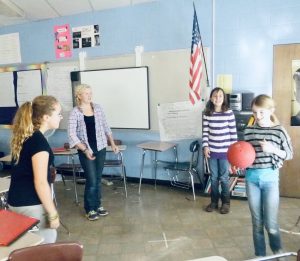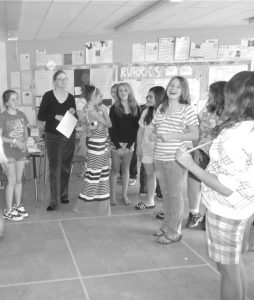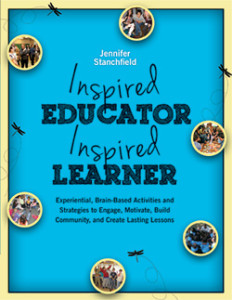Apr 11, 2024 Classroom Four Square: A Fun Example of Harnessing the Power of Play to Teach and Review

Games That Teach: Classroom Four Square
My recent post on Harnessing the Power of Play to Teach focused on how Learners of all ages can develop and practice valuable life skills through play. I shared brain research that shows that playful learning situations enhance academic and social and emotional outcomes, create supportive learning communities, instill a desire to learn, and inspire a sense of discovery. Play contributes to the development of one of our most important brain functions—the ability to control and modify our behavior in order to reach a goal.
In the article I mentioned some of my favorite review games such as Playdough Pictionary, Anyone Who, and Charades Race.
Last week during a “Games That Teach” workshop with a teaching and counseling team in Tennessee I ran across a roll of masking tape and remembered another old favorite—Classroom Four Square– a perfect activity for the final weeks of the school year when educators are looking for more active learning strategies to keep students engaged, and possibly take a review activity outside. I could see this activity also being used in some adult learning situations for a playful review strategy.
I learned this fun strategy from my colleague Anne Sulzmann, when I offered ongoing professional learning and coaching at her Vermont middle school. Classroom Four Square is an active and playful technique to engage students in content review and a perfect energizing activity anytime.
 Purpose:
Purpose:
Active engagement, academic review, formative assessment, movement, multiple pathways to learning, playful learning, social-emotional learning, executive function, self regulation, turn taking, fair play, peer interaction, quick energizer
Materials:
Tape, playground ball, review question cards
Background:
During my decade working with students and teachers at my local middle school, I had the opportunity to work closely with many innovative teachers. Anne Sulzmann taped a Four Square court in her middle school classroom and kept it ready to use throughout the year. The classic, playground game was popular with our Vermont middle schoolers, and it was one of the few group games they spontaneously initiated when they had free time outside.
 Anne used the game as an active way to engage students in review. In her version, when a person is tagged, they have a chance to answer a review question to stay in the square. The game moves quickly so everyone stays engaged. The spectators move in and out of the game, and all participants are reviewing the information whether it is their turn to answer or not!
Anne used the game as an active way to engage students in review. In her version, when a person is tagged, they have a chance to answer a review question to stay in the square. The game moves quickly so everyone stays engaged. The spectators move in and out of the game, and all participants are reviewing the information whether it is their turn to answer or not!
Facilitation Suggestions:
- Tape a square on the floor with sides of at least 6 feet, add strips of tape to divide it into four equal squares, then add the numbers in each square. If you are doing this in the classroom, desks can be rearranged accordingly—I recommend keeping the square taped to the floor for ongoing use.
- One player stands in each square, the rest of the class waits in line behind square one to enter a spot.
- The object of the game is to advance to the highest square.
- To start the game, the player in Square Four serves the ball by bouncing it in her square once and then hitting it, flat-handed, toward another square. The ball must bounce in another player’s square and they must hit it to another player before it bounces a second time, or they may hit the ball before it bounces. The receiving player hits the ball to any player in one of the other squares.
- If a player hits the ball so that it misses another player’s square, or fails to hit the ball before the second bounce after it has landed in her square, they move out of the game.
- When a player moves out, the other players move up to take their place, and the departing player moves to the end of the line.
- The academic review version moves quickly. When a person misses, instead of moving to the end of the line, they have a chance to answer an academic review question. If they give the correct answer, they get to stay in the game.
- All the participants are taking part as they listen to the review Q & A.
Facilitation Notes:
I was impressed by the level of engagement in this activity in Anne’s middle school class. Since then, I have shared her technique during my trainings with educators of all age groups. One high school teacher started using it in his science class and it continues to be a favorite—students ask to play a round to review before a test. As I explored in February’s post, Harnessing the Power of Play, never underestimate the power of play in learning!
(This is an excerpt from Inspired Educator, Inspired Learner)




No Comments